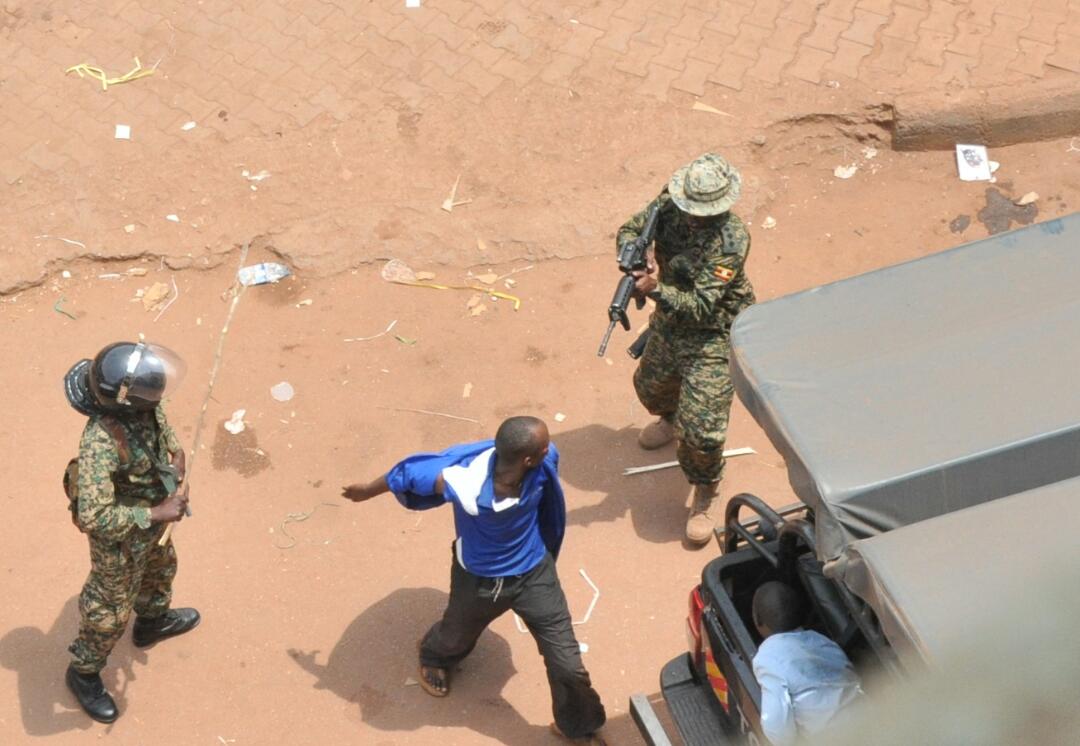
A military officer (Capt by rank) points a gun at one of the protestors at Kiseka Market, Kampala (FILE PHOTO)
By Ssekamatte Allan Mabiriizi Simonsen
Put another way: why is Buganda region so restless? This question has resurfaced with renewed, more urgent governance implications, in the aftermath of the Central Region’s overwhelming rejection of the ruling National Resistance Movement in the January 14 general elections. Buganda’s Luwero Triangle is the Movement’s politico Mecca as it hosted the five-year war that culminated in President Museveni’s ascension to power in 1986.
For the opposition National Unity Platform, Democratic Party and Forum for Democratic Change to garner over 70 percent of the available 105 parliamentary seats is a startling rupture from the consensus agreed in 1981 when Yusuf Lule’s Uganda Freedom Fighters (UFF) and with Mr Museveni’s Popular Resistance Army (PRA) merged in 1981. NRM’s near regional annihilation is more pronounced at local government level where, for example, NUP won 41 out of the 44 Kampala City councilor positions, with the rest going to FDC.
Political escapists were quick to blame a rise in Ganda nationalism, highlighting NUP presidential flag bearer Robert Kyagulanyi Ssentamu’s electoral catchphrase ‘Mwebereremu’ to imply Bobi Wine was calling for his people to vote for their kin. But that’s to miss the point, as the record number of defeated Ganda government ministers are of the same ethnicity. Besides, Derrick Nyeko, an ethnic Luo’s victory in Makindye East on a NUP ticket implies tribalism wasn’t the reason for NRM’s abysmal performance within Buganda.
The numbers don’t add up
Buganda feels increasingly marginalised in distribution of the national cake. For example, the region is home to 5,,556,574 registered voters – almost 31 percent of the national tally of 18,103,603. Why then, is it represented by only 105 MPs as opposed to 141 for the East, 124 for the North and 129 for the West? Could it be an oversight that a region that’s home to 30 percent of the country’s population (Kampala, Wakiso and Mukono alone have 2.77m voters and therefore about 10 million people), has only 20 percent of National Assembly representatives?
Buganda’s diminishing political dividend can be viewed by the arbitrary distribution of new districts and cities. For instance, between the 2016 and 2021 general elections, 52 new constituencies were created in Uganda. Most were from new districts. Some are cities and municipalities. Of these 52, eighteen (18) are in the West, 16 in the North, 10 in the East and 8 are in Central Region. It’s hardly surprising that NRM swept the West and North while performing miserably in Buganda.
In trying to understand the mathematics of January’s general elections, you must disregard statistics captured in the 2014 National Census. The counting of people exercise revealed that Kampala is home to 1.5m people while 2m residents refer to Wakiso as their place of abode. Those figures are fallacious as Kampala has 1.28m registered voters whereas Wakiso has 1.15m or thereabouts. The census clearly failed to capture children yet they outnumber adults.
In any case, those census figures are an issue for another day. The more pertinent issue is that Buganda region is underrepresented in national politics. This made it nearly impossible for NRM’s elected officials, especially government ministers, to deliver a portion of the national cake that’s commensurate to their offices. Central Region’s voters hence decided deliver a protest vote in order to redistribute the portion of cake coming from the national exchequer to fellow peasants or in local parlance, ‘Omuntu wawansi’.
November riots
Matters weren’t helped by a widely circulating but perhaps misconstrued quote on social media in which the NRM presidential candidate was heard berating Ganda nationalism. “Anytime you hear someone saying ‘ffe nga a’Baganda’ x2, just know he is an enemy of Buganda and he will be crashed,” the candidate stated. A second quote misdirected the anger at the Kabaka with the NRM candidate criticising people for telling him not to look into the monarchs mouth. “All this nonsense of Kabaka tebamutunula mu ka mwa. But politics is about okutunula mu ka mwa”, is a quote that caused a further fissure in the NRM-Buganda consensus of the 1980s.
Other factors which led to the Movement’s poor showing in Buganda include fatigue over long stay in power, an increasingly young populace, youth unemployment and rapid urbanisation within the region and scathing urban poverty As veteran journalist Onapito Okomoloit correctly intimated on the popular radio program ‘Andrew Mwenda Live’, President Museveni is widely regarded as a ‘Muganda President’. He is an adopted son of the region who restored the centuries old kingdom. This implies the schism between the Movement and Buganda isn’t irreparable. A little bit more carrot. A lot more political Schick and better thought words can repair the damage.
Comments
- Latest
- Trending





























